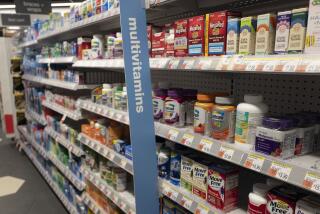Fitness Notes : All Calcium Supplements Aren’t Equal
- Share via
We know calcium is good for us. We know that without it, women--white, small-boned women, in particular--can develop a weakened bone condition called osteoporosis. We know that the government recommends that most women eat at least 800 milligrams of calcium daily. We also know that this is rather difficult to do through food only. That is probably why calcium pills have become the darling of the food supplement set.
But all calcium supplements are not created equal.
Some supplements are difficult for the body to absorb. Some, in fact, are hardly absorbed at all, according to Consumer Reports magazine, which tested seven brands of supplements and recommends only three as being easily absorbed. The test, requiring that at least 75% of a calcium tablet dissolve within 30 minutes, found three winners: Tums regular and extra-strength and Os-Cal 500.
That some calcium tablets are constructed so that they are difficult to absorb may sound peculiar, but there are logical reasons for it.
Since calcium is bulky, Consumer Reports says, manufacturers don’t have room for much filler material, such as starch. Starch can help tablets break up in the stomach. Also, calcium is chalky and difficult to swallow, so companies often coat pills with something to make them slippery. Unfortunately, the slippery surface hinders stomach acids from dissolving the pills.
While calcium pills probably are a good bet for premenopausal women who do not eat calcium-rich foods such as dairy products, experts continue to advise us to get our calcium from dinner. Then we get the pleasure of eating, as well as swallowing.
Pathological gamblers may be plagued by a disturbance in their neurochemical system that could prompt thrill-seeking behavior, according to researchers at the National Institute on Alcohol Abuse and Alcoholism in Bethesda, Md.
The researchers studied pathological gamblers by measuring levels of key brain chemicals thought to influence sensation-seeking behavior. In their study, published in Archives of General Psychiatry, they found that pathological gamblers had significantly elevated levels of the chemical messenger thought connected with sensation-seeking behavior. And the “personality trait of sensation-seeking may underlie risk-taking behavior, including pathological gambling.”
There is bad news on the child safety front: Young children can drown in seconds in less than two inches of water. Drinking mouthwash can cause a young child to fall into an alcoholic coma. In a crash at 30 m.p.h., an unbelted child would hit the dashboard with as much force as a fall from a three-story building.
But there also is good news: Although accidents are the leading killer of children, most childhood injuries can be prevented. Common sense safety is the answer.
Here are a few suggestions for preventing accidents from Children’s Hospital National Medical Center:
- Teach your children how to cross the street and don’t let them cross alone until they demonstrate they can do it.
- Insist that your child wear a helmet when cycling and restrict cycling to sidewalks, paths and driveways until age 9 or until the child understands the rules of the road as they apply to street traffic safety.
- Buckle up. Children under 40 pounds should sit in car seats. Children over 40 pounds should wear seat belts.
- Never leave your child unsupervised near water.
- Install smoke detectors near all sleeping areas and on every floor of your home. Check them to make sure they are in working order.
- Plan two fire escape routes from your home and practice them. Include an outside meeting place. Teach children to crawl if there is smoke, to call the fire department from a neighbor’s home (rather than home) and to stop running and roll on the ground if clothes catch on fire.
- Lower hot water temperature to 120 degrees. If you live in an apartment, ask the landlord or install a regulating value in the shower.
- Keep dangerous tools and poisons out of reach of children.
- Keep small objects that can be chewed and choked on out of reach.
- Install window guards, open windows from the top only or keep them locked.
- Install safety gates--not accordion gates that children can get caught in and strangle--at the top and bottom of stairs.
- Post emergency phone numbers near all phones. Include ambulance, police, fire station, poison control center, your phone number and address, pediatrician’s name and number, and your work number.
- Take a course in first aid and cardiopulmonary resuscitation.


